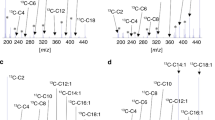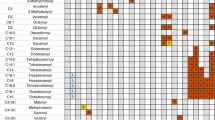Abstract
Summary: The abnormal metabolites-adipic, suberic, and sebacic acids-were detected in large amounts in the urine of a boy during a Reye's syndrome-like crisis. Substantial amounts of 5-OH-caproic acid, caproylglycine, glutaric acid, and 3-OH-butyric acid and moderately elevated amounts of ethylmalonic acid, methylsuccinic acid, 3-OH-isovaleric acid, and isovalerylglycine were also found. These metabolites were consistently present in urine samples collected in the boy's habitual condition after the attack. 1-[14C]-Palmitic acid was oxidized at a normal rate, whereas U-[14C]-Palmitic acid was oxidized at a reduced rate in cultured skin fibroblasts from the patient, thus indicating a defect at the level of medium- and/or short-chain fatty acid oxidation. Riboflavin medication (100 mg three times a day) significantly reduced the excreted amounts of pathologic metabolites, suggesting a flavineadeninedinucleotide-related acyl-CoA dehydrogenation defect as the cause of the disease.
Carnitine in plasma was low in the patient (6 μmole/liter, controls 26–74 μmole/liter), suggesting carnitine deficiency as a secondary effect of the acyl-CoA dehydrogenation deficiency.
Speculation: The present patient, who presented with a Reye's syndrome-like attack, suffers from impaired dehydrogenation of acyl-CoA resulting in accumulation of acyl-CoA in the cells. Attacks with similar symptoms are seen in other acyl-CoA dehydrogenation deficiencies, such as glutaric aciduria types I and II, other types of C6—C10-dicarboxylic acidurias and isovaleric acidemia. Reduced flow through the acyl-CoA dehydrogenation steps may therefore be an ethiologic factor in Reye's syndrome. Several of the accumulated acyl-CoA's are toxic and may be responsible for some of the symptoms. The low carnitine level in plasma and the elevated esterified carnitine excretion in the present patient indicate that acyl-CoA accumulation may cause a functional carnitine deficiency by sequestration of carnitine as acyl-carnitines. As the inborn defect, systemic carnitine deficiency may exhibit symptoms like those of Reye's syndrome, it may be speculated whether functional carnitine deficiency in patients with accumulated acyl-CoA is another causal factor in the development of the symptoms during attacks.
Similar content being viewed by others
Log in or create a free account to read this content
Gain free access to this article, as well as selected content from this journal and more on nature.com
or
Author information
Authors and Affiliations
Rights and permissions
About this article
Cite this article
Gregersen, N., Wintzensen, H., E. Christensen, S. et al. C6—C10-Dicarboxylic Aciduria: Investigations of a Patient with Riboflavin Responsive Multiple Acyl-CoA Dehydrogenation Defects. Pediatr Res 16, 861–868 (1982). https://doi.org/10.1203/00006450-198210000-00012
Issue date:
DOI: https://doi.org/10.1203/00006450-198210000-00012
This article is cited by
-
Brown‐Vialetto‐Van Laere and Fazio Londe syndromes: defects of riboflavin transport with biochemical similarities to multiple acyl‐CoA dehydrogenation defects (MADD)
Journal of Inherited Metabolic Disease (2012)
-
Mitochondrial fatty acid oxidation defects—remaining challenges
Journal of Inherited Metabolic Disease (2008)
-
Biochemical Relationships Between Reye’s and Reye’s-Like Metabolic and Toxicological Syndromes
Medical Toxicology and Adverse Drug Experience (1989)
-
The importance of recognizing secondary carnitine deficiency in organic acidaemias: Case report in glutaric acidaemia type II
Journal of Inherited Metabolic Disease (1988)
-
The inborn errors of mitochondrial fatty acid oxidation
Journal of Inherited Metabolic Disease (1987)



